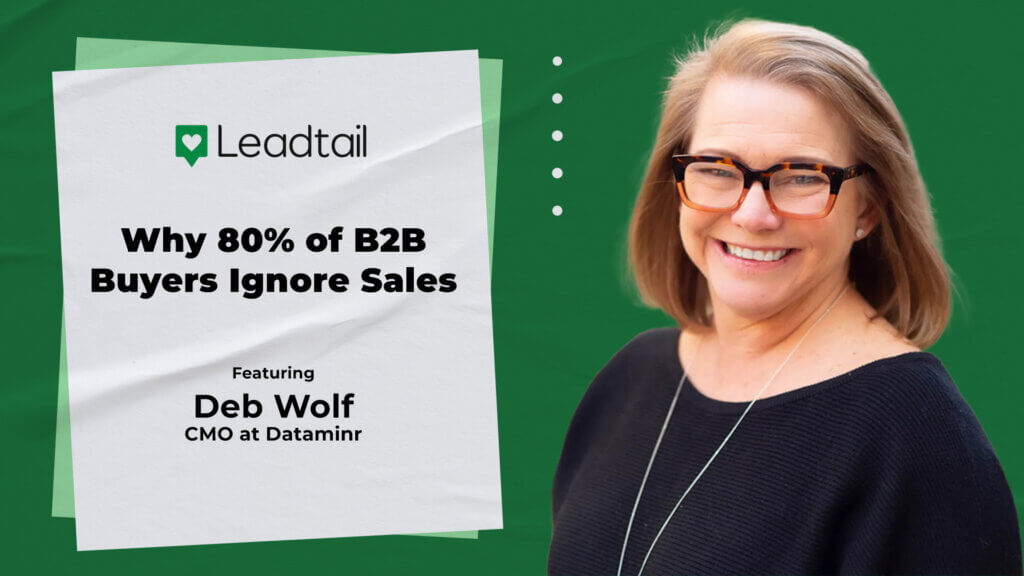As B2B agencies and marketing leaders, we’re constantly navigating a landscape defined by rapid change. The old playbooks are being rewritten in real-time, and success hinges on a new level of agility, empathy, and strategic foresight.
To understand what’s working now and what’s next, we recently sat down with Deb Wolf, the CMO at Dataminr.
With a career spanning over 35 years in B2B tech and marketing, Deb has a wealth of experience guiding companies from nascent startups to global enterprises like Workday.
Her insights are a masterclass in adapting go-to-market strategy for today’s challenges.
The B2B Buyer is in Control: The End of the Traditional Funnel
For decades, the B2B sales and marketing process was a well-choreographed dance, with marketing generating leads and sales guiding prospects through a structured funnel.
But as Deb points out, that model has been completely “shattered”. The biggest external shift, she notes, is the “further consumerization of B2B buying”.
Recent research from 6Sense, which Deb highly recommends every marketer read, reveals a startling truth: B2B buyers now initiate contact with sellers over 80% of the time.
This statistic, which sits with Deb “like a pit in my stomach,” fundamentally upends the traditional approach.
Buyers are now 70% of the way through their purchase process before they even engage with a human being.
During this “anonymized sort of Dark Web period,” they are educating themselves on solutions and problems. This new reality challenges us to reconsider foundational marketing tactics:
- Is gated content still effective? If buyers are in a self-guided research phase, locking content behind a form might be a barrier, not a tool for lead generation.
- Are MQLs the right metric? Deb argues that the traditional funnel metrics we’ve trained our exec teams and boards on—like MQLs and SQLs—are being challenged by this new buyer behavior.
- What about outbound prospecting? If buyers are initiating contact the vast majority of the time, Deb questions whether a BDR team focused on outbound is the most efficient use of resources.
Instead of focusing on traditional lead generation, Deb advises opening up content and investing more in channels like SEO to ensure you’re providing value during this crucial, anonymous research phase.
The goal is to provide a better chance of educating potential buyers before they ever reach out.
Leading a Remote-First Team with Intention
The shift to a remote and hybrid work environment has created a new set of challenges for leaders, particularly in hiring, training, and mentoring.
For Deb, whose team is fully remote, the “genie is not going back in the bottle”. This has required her to become a more intentional and conscious leader.
Deb’s approach is rooted in consistent communication and observation:
- Frequent check-ins: She conducts quarterly (and sometimes monthly) skip-level meetings to stay connected with her teams. She also holds all-hands meetings monthly, rather than quarterly.
- Observational leadership: Deb makes a point of sitting in on meetings where she isn’t strictly needed. This allows her to get a “pulse on what’s going on” and observe team dynamics.
- Intentional mentorship: Deb takes her responsibility to help her team members grow their careers very seriously. For early-career employees, she focuses on helping them understand the broader impact of their work, moving beyond a simple checklist of tasks. The challenge, she notes, is ensuring that her communication is understood as intended in this remote environment.
A Pragmatic Approach to AI: Solving Problems, Not Chasing Buzzwords
AI is a topic that can provoke both anxiety and excitement. For Deb, it’s the latter—she calls it “the thing that keeps me wanting to go another 5-10 years”.
When her CEO challenged the company to “push AI forward” and use it in their everyday work, Deb faced a challenge: no one had a clear “AI problem”.
Her solution was to flip the script: instead of looking for problems to fit an AI solution, she identified a real business problem first.
The problem? Her 24-year-old BDRs were struggling to write effective, technically accurate emails to her target audience of CIOs and CISOs. These young employees lacked the deep context of what a Fortune 500 C-suite executive deals with daily.
To solve this, she partnered with a company called embrace.ai. They built a custom agent within Slack that can integrate with a company’s public and private content. BDRs could then use the agent to generate short, well-written emails. The result? A massive increase in speed, writing quality, and learning for the team.
Deb’s key takeaway is clear:
Start with the problem you’re trying to solve, and then determine if AI is the right tool for the job.
Leveraging Data for Predictability
In this new, anonymized buyer journey, Deb emphasizes that “anonymized data is still data that we need to look at”. She gives an example of an account that has visited a company’s website multiple times. While you may not know the individual, it’s a clear signal that “something was going on” within that account.
This data can be used to become more predictive. Deb and her team use data to anticipate what will happen next in a deal. For instance, when selling a specific product, she knew that security, procurement, or IT teams would eventually get involved.
By using data to get messages in front of these key stakeholders sooner, marketing can build a level of predictability into the sales cycle.
This mindset means that marketing’s role has expanded beyond the initial lead handoff.
As Deb says, “We do not leave our leads at the door”. Marketing is now involved throughout the entire buyer’s journey, from initial research to the final purchase.
It’s a full go-to-market extension, where every touchpoint is an opportunity to provide value and guide the buyer toward a solution.
Ready to get started with B2B social media? Let’s talk!
